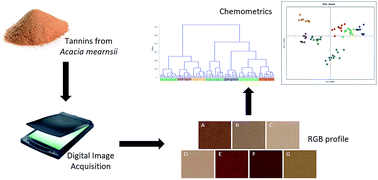Development of an inexpensive, practical and non-destructive methodology based on digital images from a scanner for the classification of commercial tannins from Acacia mearnsii†
Abstract
Among the oldest applications of tannins is leather tanning. Skin, as it is when removed from slaughtered animals, is not suitable for use by humans due to its susceptibility to attack and decomposition by bacteria. Widely found in the vegetable kingdom, condensed tannins constitute more than 90% of the total world production of commercial tannins. The bark extract from black wattle is superior to other natural tannins due to its high solubility in water, light colour and low viscosity. In this study, a methodology for the identification and classification of seven commercial tannins from Acacia mearnsii using multivariate analysis of digital images acquired through a commercial scanner was developed. The first three principal components of the principal component analysis showed a well-defined separation of the extracts into seven distinct classes. A hierarchical cluster analysis corroborates this separation. The PLS-DA supervised method showed excellent results regarding classification, with a sensitivity and specificity of 100%, with the exception of product A. Product A presented 91% sensitivity. From the results, we concluded that this method may be useful for the quality control of commercial tannins from Acacia mearnsii and correct identification, with equivalent results to those obtained with NIR without the need to invest in expensive and sophisticated equipment, according to green chemistry principles.



 Please wait while we load your content...
Please wait while we load your content...